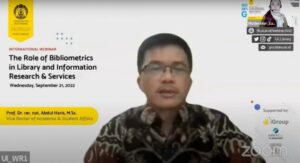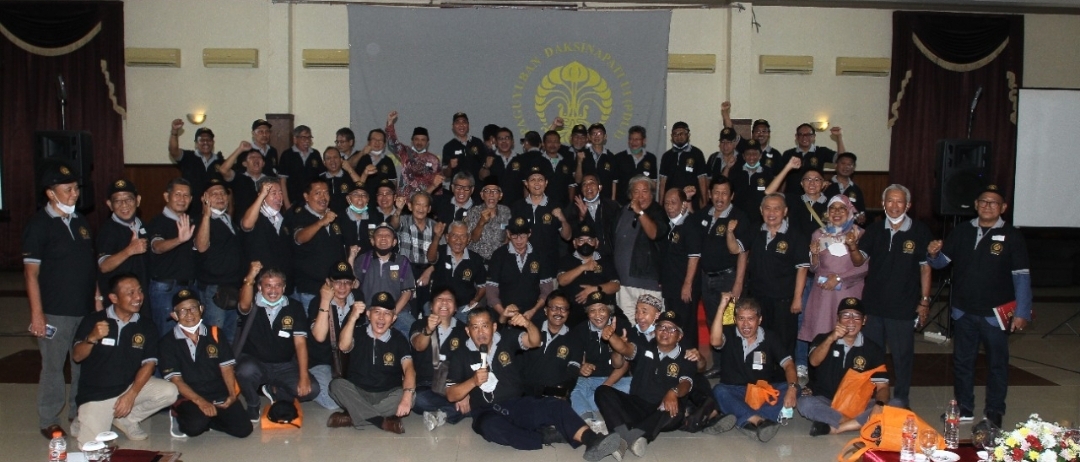
“In libraries and universities in Indonesia, bibliometric analysis is applied to analyze the use of collections, to find out the development of research on certain topics, and to help analyzing the needs of the teaching curriculum in library science study program; evaluate the suitability of the contributions of researchers’ publications to the university’s vision, mission, and research topics; as well as, the performance of individual researchers and the research performance of the university as a whole,” said the Head of the Universitas Indonesia (UI) Library Mariyah, M.Hum., in the International Webinar entitled “The Role of Bibliometrics in Library and Information Research and Services” organized by the Library. UI. Six experts were presented as speakers at the event, which are teaching assistants or research assistants at Information Science Florida State University (2018 Cohort) Muhamad Prabu Wibowo; Senior librarian of Universiti Sains Malaysia Mohd Ikhwan Ismail; Head of Scholarly Communication and Research Services of The University of Hong Kong Libraries Jesse Xiao; Associate Librarian, Learning & Research Services of The University of Hong Kong Libraries Tina Yang; Liaison Librarian – Research Support of University of Melbourne Sarah Charing & Fransie Naude.
This international webinar aimed to increase knowledge and insight into the basics of bibliometric analysis, bibliometric data sources and how to harvest them, as well as bibliometric analysis and visualization tools. In addition, Mariyah said, this webinar would reveal more about the role of bibliometrics in libraries, career paths as library professionals, and information that specializes in bibliometrics and data analysis. One of the speakers, Muhamad Prabu Wibowo, introduced bibliometrics by presenting material entitled “Introduction to Bibliometrics: Harvesting Data”. According to him, there are many data sources that can be used. “However, we must consider several things, namely, access, strengths and weaknesses, coverage, and compatibility with software where analysis and methods depend on the purpose (study), question (research), software (application), type of data (numeric, nominal, ordinal), and others,” he said. The next speaker, Mohd Ikhwan Ismail, talked about various software and visualization tools that can be used in the application of bibliometric analysis methods. “There are 4 (four) benefits that can be obtained by using bibliometric analysis methods, namely analyzing trends in individual research or fields of study, providing evidence for the impact of individual research or fields of study, discovering new and emerging areas of research, identifying potential research collaborators, and identifying sources suitable for publication,” he said. “There are 4 (four) benefits that can be obtained by using bibliometric analysis methods, which are analyzing trends in individual research or fields of study, providing evidence for the impact of individual research or fields of study, discovering new and currently developing research fields, identifying potential research collaborators, and identifying sources suitable for publication,” he said. The discussion on bibliometrics and the impact of research services was presented by Jesse Xiao and Tina Yang, along with case studies at HKU Libraries. A discussion on bibliometrics and the impact of research services was presented by Jesse Xiao and Tina Yang, with a case study at HKU Libraries. Jesse Xiao explained that metrics are proxies for productivity and performance with differences in publications, size, type, discipline, and language. HKU Libraries has 8 (eight) key metrics used including, publication counts; citation counts; citation percentile; H-index; Field Weight Citation Impact (FWCI); Category Normalized Citation Impact (CNCI); Hightly Cited Papers; and Hot Papers.
Furthermore, Tina Yang said, “To help achieve the library’s vision is by advancing the university’s teaching, learning, research and knowledge exchange activities through its outstanding resources, people-centered services as well as innovative and collaborative approaches.” In building a career in bibliometric analysis, Sarah Charing and Fransie Naude shared their experiences with Program Manager, Scholarly Development (Research) at the University of Melbourne Eleanor Colla on bibliometrics at the University of Melbourne. A librarian has a high learning intensity that extends to large projects for recruitment. Sarah Charing said the skills needed for bibliometrics include understanding HE & funding; traditional & alternative metrics; benchmarking; metadata skills; spreadsheets and visualization tools; understanding publishing and scholarly communication; critical thinking skills; and communication & networking skills with others.

UI Vice Rector for Academic and Student Affairs, Prof. Dr. rer. nat. Abdul Haris, M.Sc. provided support for the organization of the international webinar. Prof. Haris said the development of the role of librarians are increasingly active in research activities and scientific communication, and bibliometric analysis is increasingly being applied in various libraries, such as to develop library collections. “This webinar illustrates the important role of higher education libraries in education, especially in providing new knowledge and getting the right decision-making for internal and inter-unit, as well as to support SDGs goals and improve university rankings,” said Prof. Haris.



